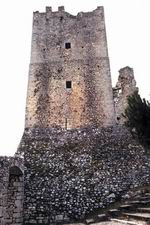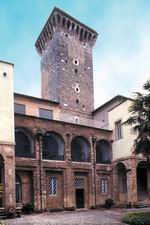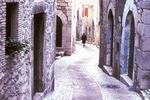| |||||
 |
Boroughs and castles in Ciociaria | ||||
| In Ciociaria many towns are perched on hilltops where usually rises a castle, a rock or a tower. | |||||
| Related images (2) |
|
This phenomenon was consequence of the 'War of Papal Investitures', when the nobles directly concerned with the appointment of the pope arranged the enfeoffment of this territory through a defensive and counter-attacking military network. The first castles, therefore, were mainly buildings founded in scarsely accessible locations, built with materials found locally and, first of all, close to the most important consular roads to reach easily Rome and Naples in case of need. Within the walls of these castles of Ciociaria, often austere yet full of fascination, it is possible to evoke the names and the stories of famous people such as Frederick II of Swabia, in fight against the papal power; Celestine V who died as a prisoner at Fumone, or the fascinating poetess, Vittoria Colonna, a pen friend of Michelangelo Buonarroti and his muse. Very soon communities gathered around these military fortresses asking protection to the 'lord' and building in this way some splendid medieval boroughs, imbued with history, art and culture, which lasted to these days. Here are presented the most interesting ones, hoping to arouse your curiosity and make you wish to discover this interesting, as well as generous and hospitable land.
THE MEDIEVAL ROCK AND THE DUKE'S PALACE OF ALVITO On top of Mount Morrone rises the Rock of Alvito with its medieval borough, surrounded by walls embattled through imposing round towers. This pretty town was governed by the Benedectines in the 10th century, by the Earls of Aquino in the Middle Ages and then by the Gallios to whom it goes the merit of the transformation and embellishment of the Duke's Palace, which today is the seat of the Town Hall. A monumental entrance hall and an imposing staircase lead to the second floor where are the famous Theatre of the court, decorated with frescoes and recently restored, as well as the Duke's Room and the Counsil Hall, containing some fine paintings from the 18th century Neapolitan school. Among the many works of art, the Church of San Simone Profeta is worth visiting for its Baroque paintings and frescoes, amde by some pupils of Luca Giordano and M. Stanzione.
AQUINO'S CASTLE After the destruction carried out by the Barbarians, the community of Aquino began to built a castle strengthened by towers to defend their town. The castle, devoted to the Holy Cross was called Castello Pretorio, i. e. magistrate's castle, because justice was administered within it. It also served as the residence of the Aquinos, the family to which Saint Thomas belonged. Recent restoration works have brought back to its original splendour the mullioned windows and the imposing rhomboidal tower looking over “Aquino's valley”, where once lay a lake drained in the 16th century.
BOVILLE ERNICA Boville Ernica is one the most fortified towns in Ciociaria. It has three rows of surrounding walls and 18 towers erected to push back the attackas of foreign armies. The village is caracterized by valuable churches and elegant Renaissance and Baroque palaces that echo the fierce chracter of this ancient stronghold. In particular, the church of San Pietro Ispano can be considered as a real case full of valuable works of art, such as the paleo-Christian sarcophagus of the 4th century AD, depicting some scenes from the Old and New Testament, as well as the porphyry Cross that was once on show at the entrance of Saint Peter's in Vatican City, so that people could worship it during the Jubileum Year; a Madonna with Child, a work by the Renaissance artist Sansovino; particularly noteworthy is the mosai angel that used to embellish St. Peter's nave, attributed to Giotto and saved by Monsignor Simoncelli from the pillage of all medieval works carried out during the renewal of the Vatican's basilica. Worth of visitng is also the parish church of Sant'Angelo with its frescoed interior and a painting attributed to the Cavalier d'Arpino. Walking through the narrow alleys and lanes of the village, your attention will certainly be drawn by the imposing bulks of Filonardi Palace, whose facade is embellished by a large portal by Vignola, as well as Vizzardelli Palace, De Angelis Palace and Saint Franci's monastery.
FUMONE'S CASTLE As you enter Fumone and go through the Gate that leads to this village-castle, you feel as if you had left the world behind and suddenly travelled back into the past reaching the Middle Ages, when this impregnable village served as a state prison. Because of its peculiar location Fumone, plaid a role through the centuries as a 'sighting post', so that it alerted Rome to possible enemies' incursions with its smoke signals. The whole urban area was then created for defensive purposes and the medieval houses encircle this castle-fortress, transformed into a noble residence by Cardinal Longhi in 1500. At the moment the castle, still belonging to the Longhis, is visited by people coming from all over the world, fascinated by the tragic history of Pope Celestine V, who died here in 1296, as a prisoner at the will of his rival Pope Boniface VIII. Inside it, there are valuable works of art, as well as the chapel devoted to Celestine V, where are kept a number of Saints' relics; on the roof a scenic hanging garden which is the largest in Europe (3,500 square metres) and one that is set and altitude of 800 m.
The bulk of this castle overlooks the inhabited area of Isola del Liri and is set against a spectacular landscape, surrounded as it is by a large park crossed by the river Liri, which drops here for 29 m creating a captivating waterfalls in the middle of the town. The castle which has undergone many remakes through the centuries, belongs today to the Viscogliosis; it has fine entertainment halls, frescoed in the 17th century, but cannot unfortunately be visited.
THE DUCAL CASTLE OF MONTE SAN GIOVANNI CAMPANO The old town of Monte San Giovanni Campano still has some enchanting corners that echo centuries of civilization, destructions and rebuildings As the area is quite limited, the view can be enjoyed at one glance. The Renaissance Palace, the heart of the citadel, has a square portal and is finely ornated in 16th-century style. The village is overlooked by the ducal Castle, first built in the 11th century, then destroyed and rebuilt many times. It had as many as 70 towers, two prisons (one for men and one for women) and a series of internal communication trenches for quick moviments of the troops in case of attack. Unfortunately these impressive fortifications resulted ineffective when the village was attacked in 1495 by Charles's VIII army, who experimented here the disastrous effects of gunpowder provoking a terrifying massacre. The fame of this village is linked to the name of St. Thomas Aquinas who was kept prisoner in the castle for two years (1238-40) at the will of his parents that disagreed with his decision to become a Dominicam monk. Young Thomas escaped from prison with the complicity of his sister, and moved to Cologne to study under Alberto Magno. Today the small chapel, devoted to him, is visited by many people who wish to examine closely the teaching of one of the most excellent minds of the Christian Church.
PIGLIO'S CASTLE Piglio's urban area develops along the ridge of a rocky spur at the foot of Mount Scalambra. Its important strategic position led to the building of a Castle-fortress, attacked then by the troops of Pope Pasquale II at war against the emperor Henry V. After having belonged to many signiories, in 1430 the castle became a possession of the Colonnas. Although partly restructured, yet the building has kept the original aspect with cross-vaulted halls. Unfortunately, nothing is left of the halls, once decorated, mentioned in a 1340 document found in the archives of the Colonnas.
TORRE CAIETANI'S CASTLE The Castle was built between the early empire age and late Middle Ages, as witnessed by several records. In the 9th century, it belonged to Teofilatto, a senator who took hold in this way of an important strategic post for the defence of his possessions in this part of Latium. The Castle plaid a defensive role also when it was bought in 1296 by Roffredo Caietani who considered it very important to oppose the Colonnas properties. Although, at the beginning, the castle was a real military 'castrum', in the 12th century was turned into a noble residence, as witnessed by the halls ornated by two-light mullioned windows that frame the beautiful underlying view of lake Canterno.
THE CASTLE OF TREVI NEL LAZIO Traces of Trevi nel Lazio are already found in the work of Pliny the Elder, who speaks about it in the 'Naturalis Historia'. In republican times, after the defeat of the Equi, treba Augusta (as was known in the past) was elevated to 'municipium' and in the empire age was granted important privilegies by the emperor Augustus, privilegies maintained also by other emperors, as witnessed by an inscription dated from 193 AD. In the Middle Ages, its peculiar geographical location in defence of the upper valley of the river Aniene led to the building of a fortified Castle, set on a limestone rock spur in the main square of the village. Pope Alexander IV had already realized how it was important to possess this strategic outpost and in the 14th century the Caietanis permanently occupied the castle for two centuries, enlarged it and arranged some living places. Today thanks to long restoration works this castle, that once was one of the most populated and large properties of the Abbey of Subiaco, can be visited.
VEROLI Veroli is an elegant town with a partly medieval and partly 18th-century architecture that witness the most flourishing periods of the history of its community. In the medieval quarter Santa Croce, there are old medieval houses which once were thrifty handicraft workshops. Piazza Mattioli is the heart of this charming little town and here are the highest representatives of civil and religious powers. The Town Hall Palace has one of the most beautiful counsil halls in Italy with walnut seats coming from an old vestry; the Cathedral of S. Andrea shelters within its walls a rich liturgy Treasure from medieval times and some valuable 18th-18th century It is impossible to leave Veroli without having walked through the charming lanes of Borgo San Leucio, a stronghold founded by the Ernici and then a medieval prison, as well as the birth place of the classic scholar Aonio Paleario.
VICO NEL LAZIO Set in defence of the Cosa Valley and of Via Prenestina, Vico still has today massive surrounding walls in limestone, broken up by 24 towers, because of which it is compared with the French town of Carcassonne. You can enter the town through one of the four entrance gates, where stands the Church of San Michele Arcangelo, which shelters on its left transept a valuable golden mosaic antependium coming from the Roman Basilica of San Giovanni in Laterano. In addition to a series of frescoes and a precious mother-of-pearl Crucifix, hand-chiselled in the East, the Church of Santa Maria keeps a small crypt with traces of ancient frescoes. Another surprise awaits you in the Church of San Martino, where is a rare wooden sculpture portraving a Madonna with Child, dating back to the 12th century: the statue features the typical Byzantine solemn stance together with the massive plasticity of Romanesque scultpures. A significant example of medieval civic building is the Governor's palace, once the residence of the Colonnas, Its massive wall structure is lightened by two-light mullioned windows and some open galleries that open up on its facade.
Texts and photos courtesy of A.P.T. di Frosinone
| |
 |
Search other Guides |
Related arguments
| Abbeys, churches and sanctuaries in Ciociaria |
| Archaeology in Ciociaria |
| Boroughs and castles in Ciociaria |
| Caves in Ciociaria |
| Ciociaria's Spas |
| Ciociaria's typical products and cuisine |
| Folklore and crafts in Ciociaria |
| Fortified towns and walls in Ciociaria |
| Lakes and rivers in Ciociaria |
| Open-air leisure activities in Ciociaria |
| Parks and natural reserve in Ciociaria |
| Skiing in Ciociaria |

 Munch: The Scream Within
Munch: The Scream WithinOne of the year’s most eagerly awaited exhibitions to open its doors on 14 September 2024: Edvard Munch is back in Milan with a major retrospective after a 40-year absence.
 In the garden
In the gardenThe initiative, which is scheduled to run from June 26th to September 13th, 2020, is inaugurating a temporary space for art in Corso Matteotti 5, in Milan, in the very heart of the city.
 Perugia Travel Guide
Perugia Travel GuidePerugia is the chief town of Umbria. This beautiful town is sited on a hill in the middle of a verdant country. His central square is considered one of the most beautiful squares of Italy and history, traditions, art and nature make a unique ensemble in this town as in the whole





 ISOLA DEL LIRI'S CASTLE
ISOLA DEL LIRI'S CASTLE
 paintings. The basilica of Santa Salome, the patron saint of the town, is extremely interesting from the religious point of view. Medieval chronicles hold that Salome, the pious mother of the apostles John and James, brought a fragment of Christ's cross whose authenticity was endorsed by pope Benedict XIV who in 1751 gave permission to built a Holy Stairs for the expiation of sins. The nearby Gallery la Catena is worth visitng for its permanent exhibition of paintings by Francis Cox, a leading representative of contemporary art, together with the Giovardiana Library, a real shrine of culture with its illuminated manuscripts, the parchments and the 16th-century prints.
paintings. The basilica of Santa Salome, the patron saint of the town, is extremely interesting from the religious point of view. Medieval chronicles hold that Salome, the pious mother of the apostles John and James, brought a fragment of Christ's cross whose authenticity was endorsed by pope Benedict XIV who in 1751 gave permission to built a Holy Stairs for the expiation of sins. The nearby Gallery la Catena is worth visitng for its permanent exhibition of paintings by Francis Cox, a leading representative of contemporary art, together with the Giovardiana Library, a real shrine of culture with its illuminated manuscripts, the parchments and the 16th-century prints.